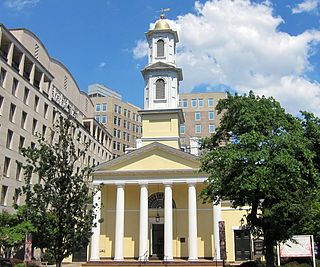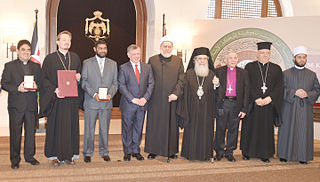
Religious affiliations can affect the electability of the presidents of the United States and shape their stances on policy matters and their visions of society and also how they want to lead it. While no president has ever openly identified as an atheist, Thomas Jefferson, Abraham Lincoln, and William Howard Taft were speculated to be atheists by their opponents during political campaigns; in addition, a survey during the presidency of Donald Trump showed that 63% of Americans did not believe he was religious, despite his professed Christian affiliation. Trump supporters have also circulated conspiracy theories that Barack Obama is a Muslim. Conversely, other presidents, such as Jimmy Carter, have used their faith as a defining aspect of their campaigns and tenure in office.
The United Methodist Church (UMC) is a worldwide mainline Protestant denomination based in the United States, and a major part of Methodism. In the 19th century, its main predecessor, the Methodist Episcopal Church, was a leader in evangelicalism. The present denomination was founded in 1968 in Dallas, Texas, by union of the Methodist Church and the Evangelical United Brethren Church. The UMC traces its roots back to the revival movement of John and Charles Wesley in England, as well as the Great Awakening in the United States. As such, the church's theological orientation is decidedly Wesleyan. It embraces liturgical worship, holiness, and evangelical elements.

The headquarters of the United Nations (UN) is on 17 to 18 acres of grounds in the Turtle Bay neighborhood of Midtown Manhattan in New York City. It borders First Avenue to the west, 42nd Street to the south, 48th Street to the north, and the East River to the east. Completed in 1952, the complex consists of several structures, including the Secretariat, Conference, and General Assembly buildings, and the Dag Hammarskjöld Library. The complex was designed by a board of architects led by Wallace Harrison and built by the architectural firm Harrison & Abramovitz, with final projects developed by Oscar Niemeyer and Le Corbusier. The term Turtle Bay is occasionally used as a metonym for the UN headquarters or for the United Nations as a whole.

A civil marriage is a marriage performed, recorded, and recognized by a government official. Such a marriage may be performed by a religious body and recognized by the state, or it may be entirely secular.

Interfaith dialogue refers to cooperative, constructive, and positive interaction between people of different religious traditions and/or spiritual or humanistic beliefs, at both the individual and institutional levels.

Hak Ja Han Moon is an international religious leader. Her late husband Sun Myung Moon was the founder of the Unification Church (UC). Han and Moon were married in April 1960 and have 10 living children and over 30 grandchildren. In 1992, she established the Women's Federation for World Peace, and traveled the world speaking on its behalf. Since her husband's death, she has assumed leadership of the Unification Church, whose followers call her "True Mother" and "Mother of Peace".
Interfaith marriage, sometimes called interreligious marriage or "mixed marriage", is marriage between spouses professing different religions. Although interfaith marriages are often established as civil marriages, in some instances they may be established as a religious marriage. This depends on religious doctrine of each of the two parties' religions; some prohibit interfaith marriage, and among others there are varying degrees of permissibility.
Anwarul Karim Chowdhury is a Bangladeshi diplomat most noted for his work on development in the poorest nations, global peace and championing the rights of women and children. In a speech he gave in 2005, Chowdhury stated: "We should not forget that when women are marginalized, there is little chance for an open and participatory society." In his role as the leading United Nations Culture of Peace emissary, he said in May 2010 that peace efforts would continually fail until people embraced humanity's oneness.

The World Methodist Council (WMC), founded in 1881, is a consultative body and association of churches in the Methodist tradition. It comprises 80 member denominations in 138 countries which together represent an estimated 80 million people; this includes approximately 60 million committed members and a further 20 million adherents. But there is also another, contradictory, number of members of the member churches on the WMC's website: about 40 million. It is the fifth-largest Christian communion after the Roman Catholic Church, Eastern Orthodox Church, Anglican Communion, and World Communion of Reformed Churches.

The General Commission on Christian Unity and Interreligious Concerns (GCCUIC) addresses the interreligious and ecumenical concerns of The United Methodist Church. The GCCUIC's office is located at The Interchurch Center in New York City. The Commission's President is Bishop Mary Ann Swenson and the General Secretary is Stephen J. Sidorak Jr. The Ecumenical Officer of the Council of Bishops is Bishop Sharon Zimmerman Rader and serves as the corporate ecumenical officer of The United Methodist Church, working in collaboration with GCCUIC.

Vern Barnet is a Unitarian Universalist pastor and was the weekly newspaper columnist on religious topics in The Kansas City Star 1994-2012. He is the founder of the Kansas City (area) Interfaith Council.
The Temple of Understanding is an interfaith organization founded in 1960 by Juliet Hollister and located in New York City.

Leah D. Daughtry is an American political operative.

The Interchurch Center is a 19-story limestone-clad office building located at 475 Riverside Drive and West 120th Street in Morningside Heights, Manhattan, New York City. It is the headquarters for the international humanitarian ministry Church World Service, and also houses a wide variety of church agencies and ecumenical and interfaith organizations as well as some nonprofit foundations and faith-related organizations, including the Religion Communicators Council. The National Council of Churches also occupied the building from its inception, but in February 2013, the NCC consolidated its offices on Capitol Hill in Washington, DC, and vacated its New York headquarters facilities. NCC's sister agency, Church World Service, remains a tenant in the building.

World Interfaith Harmony Week is a UN resolution for a worldwide week of interfaith harmony proposed in 2010 by King Abdullah II and Prince Ghazi bin Muhammad of Jordan. The World Interfaith Harmony Week falls in the first week of February of every year and aims to promote harmony between all people regardless of their faith.

The Interfaith Center for Sustainable Development (ICSD), is a nonprofit organization, founded and directed by Rabbi Yonatan Neril in 2010. Based in Jerusalem, ICSD connects religion and ecology and mobilizes faith communities to act. ICSD's director has spoken at the World Economic Forum in Davos, multiple UN climate conferences, and the Parliament of World Religions.

Yonatan Neril is an interfaith environmental advocate, NGO director, and rabbi. He is the founder and current director of the Interfaith Center for Sustainable Development (ICSD), a non-profit organization based in Jerusalem.

The Millennium Peace Summit of Religious and Spiritual Leaders was held in New York City between August 28–31, 2000. The meeting recognized the importance of religion to world peace and faith leaders’ commitment to peacekeeping, poverty relief, and environmental conservation. It preceded the Millennium Summit, which commemorated the 50th anniversary of the United Nations (UN).
Sun Myung Moon, founder of the Unification Church, believed in a literal Kingdom of God on earth to be brought about by human effort, motivating his establishment of numerous groups, some that are not strictly religious in their purposes. Moon was not directly involved with managing the day-to-day activities of the organizations that he indirectly oversaw, yet all of them attribute the inspiration behind their work to his leadership and teachings.















